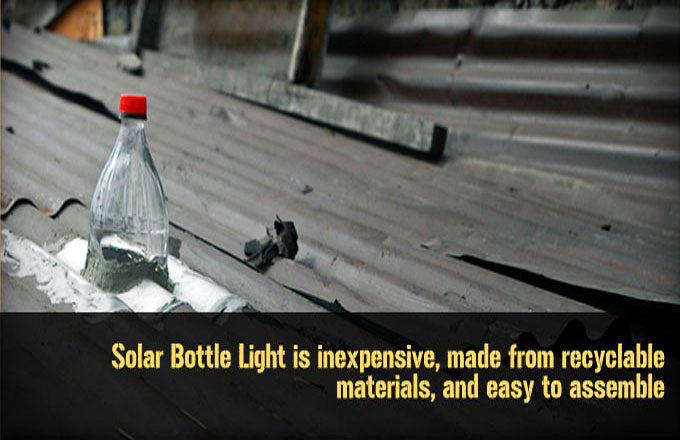Here is an addition to my gallery of educational events. Here is the story of someone(s) who figured out that plastic bottles can provide lighting…
The link came to me through my son who got it from …. (probably a long list of referrals with mention of “amazing video”–and this is also an educational event) Here is the link:
http://www.wimp.com/innovationfinest/
The story is told as one person coming up with an idea, refining it, and then convincing people in his “squatter area” (in English in the local language) to use it. There was here a hint of network that transformed an individual act into a communal educational event. And this, of course, is what is wonderful about the event. The editors of wimp.com provide a link to Isang Litrong Liwanak, a web site for the project.
This link reveals that, not so surprisingly anymore, the network has wildly expanded. And that of course, suggest more educational events by more and more people.
This another case that would make a delightful research project. Who did what when, for the first time, using what machines, and, most importantly, with whom?

Here is a link to an article that describes an interesting variation on the notion of communal education. Entitled Seeing Value in Ignorance, College Expects Its Physicists to Teach Poetry, the article opens with a PhD in art history teaching an undergraduate course in formal geometry, not for lack of a more traditionally qualified instructor, but specifically because of her limited knowledge of the subject matter. The approach to education at St. John’s college in Annapolis MD is to “leverage ignorance” because, in the words of its president, “Learning is born of ignorance;” knowledge is gained through a sort of collaborative exploration of content.
As I read, I eagerly awaited the reference to Ranciere. Clearly the approach rejects the principle of inequality between Master and student that Ranciere describes, and seeks to avert the subsequent “stulification” of the intellect. According to Ranciere, “whenever the ignorant one’s knowledge and the master’s ignorance, by becoming equal, demonstrate the powers of intellectual equality” the “pure powers of reason” are liberated. At least one instructor at St. John’s is in agreement: “You have to not try to control things,” Mr. Dink said, “and not think that what’s learned has to come from you.”
Sadly, the article made no reference to Ranciere, or the Ignorant Schoolmaster from whom the title seems to have been derived. An interesting read, nonetheless.
http://www.nytimes.com/2011/10/17/education/17stjohn.html?_r=1&sq=ignorance college&st=cse&scp=1&pagewanted=all
The solar bottle light is an example of the creative intelligence that has potential to surface to solve everyday dilemmas by people becoming active home and community improvement participants. Dewey noted that “solutions to complex problems can be found by the exercise of creative intelligence on the part of all those involved in the problems” (as cited in Sinclar & Ghory, 1997). Therefore, with Dewey’s statement, creative intelligence is not limited to one person but is characteristic of all those involved in the problem. Thus, one may see that the solar bottle light is one such example of creative intelligence in that the light was not simply an example of one person’s ingenuity, but that of a group. A group of people found this idea so useful that the word was spread worldwide about the light. Many people living in similar housing situations, working in, or attending institutions comprised of the same building materials had to identify that this light was useful in order for it to become a global phenomenon. If it had just been an idea for one person in one situation, the light still could have been useful. The fact that the light is useful in many contexts by many groups of people worldwide supports that it is a prime example of creative intelligence.
The solar light bottle also reminds me of a friend and colleague’s work. Clarisa Diaz designs tool kits with local communities(www.placesforall.com) that host solutions community members have found to problems experienced by groups. One example is a toolkit designed with students in Cambodia. Many students live in rural areas and travel long distances by motorbike to study at the university. However, due to the rural road conditions, or lack thereof, many bikes break down. Diaz, along with a group of Cambodians, designed a tool kit that students could use when they experienced bike problems. The kit explains several common problems and solutions using local materials to fix the bikes. Creative intelligence was employed by Diaz and the Cambodian team to design a toolkit that offered solutions for a group, just as the solar bottle light was a solution for a group. Diaz’s tool kit could be useful in many global contexts where motorbikes are the means of transport.
Both examples, the solar bottle light and Diaz’s tool kit lead one to wonder how many other examples of creative intelligence exist throughout the world, going unnoticed, that could be viable solutions to various groups’ dilemmas? What does an idea need for it to become recognized? Who needs to recognize an idea for it to gain local, national, or international attention and how does it garner this attention? How may more acts of creative intelligence be made visible, examples that may not be tangibly visible, such as the light on the outside of a house? What are the cases and causes in which a person sees him or herself as an active participant capable of improving daily dilemmas? These are questions that more research could begin providing the answers on to better understand concepts such as Lave and Wenger’s peripheral participation and Dewey’s creative intelligence.